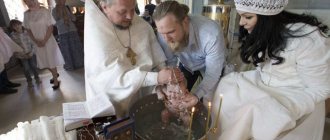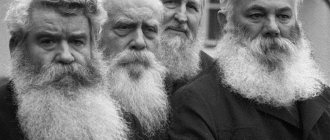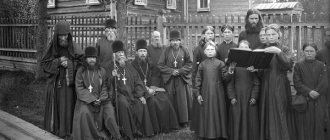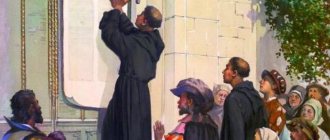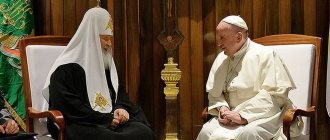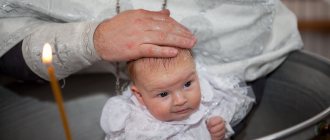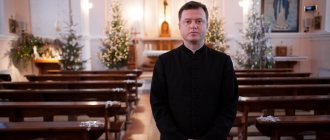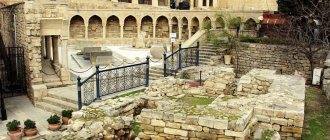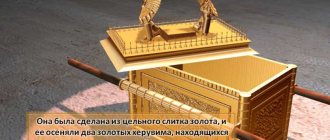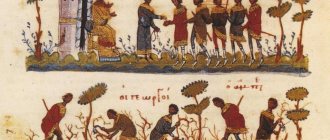Not only Orthodox believers are called Christians. Protestants and Catholics are also Christians. There are 3 main directions of religion, which is based on the life and covenants of Jesus Christ:
- Orthodoxy.
- Catholicism.
- Protestantism.
For those who are thinking about a relationship with God, it is important to know the difference between these religions.
Historically, the apostles of Jesus Christ created the One Holy Catholic Apostolic Church, which consisted of 5 main Local Churches:
- The Jerusalem Local Church was founded by the Apostle James;
- Antioch Local Church - by the apostles Peter and Paul;
- Alexandria Local Church - by the Apostle Mark;
- Constantinople Local Church - Apostle Andrew;
- Roman Local Church - by the Apostle Peter.
Apostle Andrew, who founded the Local Church of Constantinople, which in turn began to be called Orthodox in 1054
How did the separations happen?
The Orthodox Church has preserved intact the truth that the Lord Jesus Christ revealed to the apostles. But the Lord Himself warned His disciples that from among those who would be with them there would appear people who would want to distort the truth and muddy it with their own inventions: Beware of false prophets, who come to you in sheep’s clothing, but inwardly they are ravenous wolves (Matthew 7) , 15).
And the apostles also warned about this. For example, the Apostle Peter wrote: you will have false teachers who will introduce destructive heresies and, denying the Lord who bought them, will bring swift destruction upon themselves. And many will follow their depravity, and through them the path of truth will be reproached... Having left the straight path, they have gone astray... the darkness of eternal darkness is prepared for them (2 Pet. 2 , 1-2, 15, 17).
Heresy is understood as a lie that a person follows consciously. The path that Jesus Christ opened requires dedication and effort from a person so that it becomes clear whether he really entered this path with firm intention and love for the truth. It is not enough to just call yourself a Christian; you must prove with your deeds, words and thoughts, with your whole life, that you are a Christian. He who loves the truth, for its sake, is ready to renounce all lies in his thoughts and his life, so that the truth may enter into him, cleanse and sanctify him.
But not everyone embarks on this path with pure intentions. And their subsequent life in the Church reveals their bad mood. And those who love themselves more than God fall away from the Church.
There is a sin of action - when a person violates the commandments of God by deed, and there is a sin of mind - when a person prefers his lie to the Divine truth. The second is called heresy. And among those who called themselves Christians at different times, there were both people devoted to the sin of action, and people devoted to the sin of the mind. Both people resist God. Either person, if he has made a firm choice in favor of sin, cannot remain in the Church and falls away from it. Thus, throughout history, everyone who chose sin left the Orthodox Church.
The Apostle John said about them: They went out from us, but they were not ours: for if they were ours, they would have remained with us; but they went out, and through this it was revealed that they were not all ours (1 Jn. 2, 19).
Their fate is unenviable, because the Scripture says that those who indulge in heresies... will not inherit the kingdom of God (Gal. 5, 20-21).
Precisely because a person is free, he can always make a choice and use freedom either for good, by choosing the path to God, or for evil, by choosing sin. This is the reason that false teachers arose and those who believed them more than Christ and His Church arose.
When heretics appeared, introducing lies, the holy fathers of the Orthodox Church began to explain to them their errors and called on them to abandon fiction and turn to the truth. Some, convinced by their words, were corrected, but not all. And about those who persisted in lies, the Church pronounced its judgment, testifying that they were not true followers of Christ and members of the community of the faithful founded by Him. This is how the apostolic advice was fulfilled: turn away from the heretic after the first and second admonition, knowing that such a one has become corrupt and sins, being self-condemned (Tit. 3, 10-11).
There have been many such people in history. The most widespread and numerous of the communities they founded that have survived to this day are the Monophysite Eastern Churches (they arose in the 5th century), the Roman Catholic Church (which fell away from the Ecumenical Orthodox Church in the 11th century) and Churches that call themselves Protestant. Today we will look at how the path of Protestantism differs from the path of the Orthodox Church.
Protestantism
If any branch breaks off from a tree, then, having lost contact with the vital juices, it will inevitably begin to dry out, lose its leaves, become fragile and easily break at the first onslaught.
The same is evident in the life of all communities that separated from the Orthodox Church. Just as a broken branch cannot retain its leaves, so those who are separated from true church unity can no longer maintain their inner unity. This happens because, having left God’s family, they lose touch with the life-giving and saving power of the Holy Spirit, and that sinful desire to resist the truth and put themselves above others, which led them to fall away from the Church, continues to operate among those who have fallen away, turning already against them and leading to ever new internal divisions.
So, in the 11th century, the Local Roman Church separated from the Orthodox Church, and at the beginning of the 16th century, a significant part of the people already separated from it, following the ideas of the former Catholic priest Luther and his like-minded people. They formed their own communities, which they began to consider as the “Church”. This movement is collectively called Protestants, and their separation itself is called the Reformation.
In turn, Protestants also did not maintain internal unity, but began to divide even more into different currents and directions, each of which claimed that it was the real Church of Jesus Christ. They continue to divide to this day, and now there are already more than twenty thousand of them in the world.
Each of their directions has its own peculiarities of doctrine, which would take a long time to describe, and here we will limit ourselves to analyzing only the main features that are characteristic of all Protestant nominations and which distinguish them from the Orthodox Church.
The main reason for the emergence of Protestantism was a protest against the teachings and religious practices of the Roman Catholic Church.
As Saint Ignatius (Brianchaninov) notes, indeed, “many misconceptions have crept into the Roman Church. Luther would have done well if, having rejected the errors of the Latins, he had replaced these errors with the true teaching of the Holy Church of Christ; but he replaced them with his own errors; Some of Rome’s misconceptions, very important ones, were fully followed, and some were strengthened”[1]. “The Protestants rebelled against the ugly power and divinity of the popes; but since they acted on the impulse of passions, drowning in depravity, and not with the direct goal of striving for the holy Truth, they did not turn out to be worthy to see it.”[2].
They abandoned the erroneous idea that the Pope is the head of the Church, but retained the Catholic error that the Holy Spirit comes from the Father and the Son.
However, even in the fact that they abandoned the erroneous Catholic teaching about the Pope, they did not come closer to Orthodoxy, because, as Saint Hilarion (of the Trinity) said, “Protestantism was a protest on the same plane; he did not restore ancient Christianity, but replaced one distortion of Christianity with another... Truth and salvation were given to the Church. Latinism, having fallen away from the Church, betrayed this consciousness and proclaimed: the truth is given to the individual person of the pope - albeit one pope, but still a separate person - and the pope is in charge of the salvation of all. Protestantism only objected: why is the truth given only to the pope? - and added: truth and salvation are open to every individual, regardless of the Church. Each individual man was made an infallible pope. Protestantism... with its countless number of popes completely destroyed the idea of the Church, replaced faith with the reason of an individual and replaced salvation in the Church with the dreamy confidence in salvation through Christ without the Church, in selfish isolation... The principled side of Protestantism came very close to the heart of human selfishness and self-will of all kinds. Selfishness and self-will... are revealed in the endless division and fragmentation of Protestantism itself”[3].
Orthodoxy and Protestantism: what is the difference?
How did the separations happen?
The Orthodox Church has preserved intact the truth that the Lord Jesus Christ revealed to the apostles. But the Lord Himself warned His disciples that from among those who would be with them there would appear people who would want to distort the truth and muddy it with their own inventions: Beware of false prophets, who come to you in sheep’s clothing, but inwardly they are ravenous wolves (Matthew 7). , 15).
And the apostles also warned about this. For example, the Apostle Peter wrote: you will have false teachers who will introduce destructive heresies and, denying the Lord who bought them, will bring upon themselves quick destruction. And many will follow their debauchery, and through them the way of truth will be reproached... Having left the straight path, they have gone astray... the darkness of eternal darkness is prepared for them (2 Pet. 2: 1-2, 15, 17).
Heresy is understood as a lie that a person follows consciously. The path that Jesus Christ opened requires dedication and effort from a person so that it becomes clear whether he really entered this path with firm intention and love for the truth. It is not enough to just call yourself a Christian; you must prove with your deeds, words and thoughts, with your whole life, that you are a Christian. He who loves the truth, for its sake, is ready to renounce all lies in his thoughts and his life, so that the truth may enter into him, cleanse and sanctify him.
But not everyone embarks on this path with pure intentions. And their subsequent life in the Church reveals their bad mood. And those who love themselves more than God fall away from the Church.
There is a sin of action - when a person violates the commandments of God by deed, and there is a sin of mind - when a person prefers his lie to the Divine truth. The second is called heresy. And among those who called themselves Christians at different times, there were both people devoted to the sin of action, and people devoted to the sin of the mind. Both people resist God. Either person, if he has made a firm choice in favor of sin, cannot remain in the Church and falls away from it. Thus, throughout history, everyone who chose sin left the Orthodox Church.
Benozzo Gozzoli. Repentance of heretics
The Apostle John said about them: They went out from us, but they were not ours: for if they were ours, they would have remained with us;
but they went out, and through this it was revealed that they were not all ours (1 John 2:19 ).
Their fate is unenviable, because Scripture says that those who indulge in heresies... will not inherit the Kingdom of God (Gal. 5 , 20-21).
Precisely because a person is free, he can always make a choice and use freedom either for good, by choosing the path to God, or for evil, by choosing sin. This is the reason that false teachers arose and those who believed them more than Christ and His Church arose.
When heretics appeared, introducing lies, the holy fathers of the Orthodox Church began to explain to them their errors and called on them to abandon fiction and turn to the truth. Some, convinced by their words, were corrected, but not all. And about those who persisted in lies, the Church pronounced its judgment, testifying that they were not true followers of Christ and members of the community of the faithful founded by Him. This is how the apostolic advice was fulfilled: turn away from the heretic after the first and second admonition, knowing that such a one has become corrupt and sins, being self-condemned (Tit. 3, 10–11).
There have been many such people in history. The most widespread and numerous of the communities they founded that have survived to this day are the Monophysite Eastern Churches (they arose in the 5th century), the Roman Catholic Church (which fell away from the Ecumenical Orthodox Church in the 11th century) and Churches that call themselves Protestant. Today we will look at how the path of Protestantism differs from the path of the Orthodox Church.
Protestantism
If any branch breaks off from a tree, then, having lost contact with the vital juices, it will inevitably begin to dry out, lose its leaves, become fragile and easily break at the first onslaught.
The same is evident in the life of all communities that separated from the Orthodox Church. Just as a broken branch cannot retain its leaves, so those who are separated from true church unity can no longer maintain their inner unity. This happens because, having left God’s family, they lose touch with the life-giving and saving power of the Holy Spirit, and that sinful desire to resist the truth and put themselves above others, which led them to fall away from the Church, continues to operate among those who have fallen away, turning already against them and leading to ever new internal divisions.
So, in the 11th century, the Local Roman Church separated from the Orthodox Church, and at the beginning of the 16th century, a significant part of the people already separated from it, following the ideas of the former Catholic priest Luther and his like-minded people. They formed their own communities, which they began to consider as the “Church”. This movement is collectively called Protestants, and their separation itself is called the Reformation.
Martin Luther. Portrait
In turn, Protestants also did not maintain internal unity, but began to divide even more into different currents and directions, each of which claimed that it was the real Church of Jesus Christ. They continue to divide to this day, and now there are already more than twenty thousand of them in the world.
Each of their directions has its own peculiarities of doctrine, which would take a long time to describe, and here we will limit ourselves to analyzing only the main features that are characteristic of all Protestant nominations and which distinguish them from the Orthodox Church.
The main reason for the emergence of Protestantism was a protest against the teachings and religious practices of the Roman Catholic Church.
As Saint Ignatius (Brianchaninov) notes, indeed, “many misconceptions have crept into the Roman Church. Luther would have done well if, having rejected the errors of the Latins, he had replaced these errors with the true teaching of the Holy Church of Christ; but he replaced them with his own errors; Some of Rome’s misconceptions, very important ones, were fully followed, and some were strengthened”[1]. “The Protestants rebelled against the ugly power and divinity of the popes; but since they acted on the impulse of passions, drowning in depravity, and not with the direct goal of striving for the holy Truth, they did not turn out to be worthy to see it.”[2].
They abandoned the erroneous idea that the Pope is the head of the Church, but retained the Catholic error that the Holy Spirit comes from the Father and the Son.
However, even in the fact that they abandoned the erroneous Catholic teaching about the Pope, they did not come closer to Orthodoxy, because, as Saint Hilarion (of the Trinity) said, “Protestantism was a protest on the same plane; he did not restore ancient Christianity, but replaced one distortion of Christianity with another... Truth and salvation were given to the Church. Latinism, having fallen away from the Church, betrayed this consciousness and proclaimed: the truth is given to the individual person of the pope - albeit one pope, but still a separate person - and the pope is in charge of the salvation of all. Protestantism only objected: why is the truth given only to the pope? - and added: truth and salvation are open to every individual, regardless of the Church. Each individual man was made an infallible pope. Protestantism... with its countless number of popes completely destroyed the idea of the Church, replaced faith with the reason of an individual and replaced salvation in the Church with the dreamy confidence in salvation through Christ without the Church, in selfish isolation... The principled side of Protestantism came very close to the heart of human selfishness and self-will of all kinds. Selfishness and self-will... are revealed in the endless division and fragmentation of Protestantism itself”[3].
Scripture
Protestants formulated the principle: “Scripture only,” which means that they recognize only the Bible as its authority, and they reject the Holy Tradition of the Church.
And in this they contradict themselves, because the Holy Scripture itself points to the need to honor the Holy Tradition coming from the Apostles: stand and keep the traditions that you have been taught either by word or by our epistle (2 Thess. 2:15 ), writes the Apostle Paul.
If a person writes some text and distributes it to different people, and then asks them to explain how they understood it, then it will probably turn out that someone understood the text correctly, and someone incorrectly, putting their own meaning into these words. It is known that any text has different options for understanding. They may be true, or they may be wrong. The same is true with the text of Holy Scripture, if we tear it away from Holy Tradition. Indeed, Protestants think that Scripture should be understood the way anyone wants. But this approach cannot help to find the truth.
Here is how Saint Nicholas of Japan wrote about this: “Japanese Protestants sometimes come to me and ask me to explain some passage of Holy Scripture. “Yes, you have your own missionary teachers - ask them,” I tell them. “What do they answer?” “We asked them, they said: understand as you know; but I need to know the true thought of God, and not my personal opinion”... It’s not like that with us, everything is light and reliable, clear and solid - because in addition to the Holy Scriptures, we also accept the Holy Tradition, and the Holy Tradition is a living, uninterrupted voice... our Church from the time of Christ and His Apostles until now, which will be until the end of the world. The whole of Holy Scripture is based on it.”[4]
The Apostle Peter himself testifies that no prophecy in Scripture can be resolved by oneself, for prophecy was never pronounced by the will of man, but holy men of God spoke it, being moved by the Holy Spirit (2 Pet. 1 , 20-21). Accordingly, only holy fathers, moved by the same Holy Spirit, can reveal to man a true understanding of the Word of God.
Holy Scripture and Holy Tradition form one inseparable whole, and have been so from the very beginning.
Not in writing, but orally, the Lord Jesus Christ revealed to the apostles how to understand the Holy Scriptures of the Old Testament (Luke 24:27), and they taught the same thing orally to the first Orthodox Christians. Protestants want to imitate the early apostolic communities in their structure, but in the early years the early Christians had no New Testament scriptures at all, and everything was passed on from mouth to mouth, like tradition.
The Bible was given by God for the Orthodox Church; it was in accordance with the Holy Tradition that the Orthodox Church at its Councils approved the composition of the Bible; it was the Orthodox Church, long before the appearance of Protestants, that lovingly preserved the Holy Scriptures in its communities.
Protestants, using the Bible, which was not written by them, not collected by them, not preserved by them, reject the Holy Tradition, and thereby close to themselves the true understanding of the Word of God. Therefore, they often argue about the Bible and often come up with their own, human traditions, which have no connection either with the apostles or with the Holy Spirit, and fall, according to the word of the apostle, into empty deception, according to human tradition... and not according to Christ (Col. 2, 8).
Sacraments
Protestants rejected the priesthood and sacred rites, not believing that God could act through them, and even if they left something similar, it was only the name, believing that these were only symbols and reminders of historical events remaining in the past, and not a holy reality in itself. Instead of bishops and priests, they got themselves pastors who have no connection with the apostles, no succession of grace, as in the Orthodox Church, where every bishop and priest has the blessing of God, which can be traced from our days to Jesus Christ Himself. The Protestant pastor is only a speaker and administrator of the life of the community.
As Saint Ignatius (Brianchaninov) says, “Luther... passionately rejecting the lawless power of the popes, rejected the legal power, rejected the episcopal rank itself, the consecration itself, despite the fact that the establishment of both belonged to the apostles themselves... rejected the Sacrament of Confession, although all Holy Scripture testifies that it is impossible to receive remission of sins without confessing them.”[5]. Protestants also rejected other sacred rites.
Veneration of the Virgin Mary and saints
The Most Holy Virgin Mary, who gave birth to the human race of the Lord Jesus Christ, prophetically said: from now on all generations will bless Me (Luke 1:48 ). This was said about the true followers of Christ - Orthodox Christians. And indeed, from then until now, from generation to generation, all Orthodox Christians have venerated the Most Holy Theotokos, the Virgin Mary. But Protestants do not want to honor and please her, contrary to Scripture.
The Virgin Mary, like all the saints, that is, people who have walked to the end along the path of salvation opened by Christ, have united with God and are always in harmony with Him.
The Mother of God and all the saints became the closest and most beloved friends of God. Even a person, if his beloved friend asks him for something, will definitely try to fulfill it, and God also willingly listens and quickly fulfills the requests of the saints. It is known that even during his earthly life, when they asked, He certainly responded. So, for example, at the request of the Mother, He helped the poor newlyweds and performed a miracle at the feast to save them from shame (John 2:1-11).
Scripture reports that God is not the God of the dead, but of the living, for with Him all are alive (Luke 20:38). Therefore, after death, people do not disappear without a trace, but their living souls are maintained by God, and those who are holy retain the opportunity to communicate with Him. And Scripture directly says that departed saints make requests to God and He hears them (see: Rev. 6:9-10). Therefore, Orthodox Christians venerate the Most Holy Virgin Mary and other saints and turn to them with requests that they intercede with God on our behalf. Experience shows that many healings, deliverances from death and other help are received by those who resort to their prayerful intercession.
For example, in 1395, the great Mongol commander Tamerlane with a huge army went to Russia to capture and destroy its cities, including the capital, Moscow. The Russians did not have enough strength to resist such an army. Orthodox residents of Moscow began to earnestly ask the Most Holy Theotokos to pray to God to save them from the impending disaster. And so, one morning Tamerlane unexpectedly announced to his military leaders that they needed to turn the army around and go back. And when asked about the reason, he answered that at night in a dream he saw a great mountain, on the top of which stood a beautiful shining woman, who ordered him to leave the Russian lands. And, although Tamerlane was not an Orthodox Christian, out of fear and respect for the holiness and spiritual power of the appeared Virgin Mary, he submitted to Her.
Prayers for the dead
Those Orthodox Christians who during their lifetime were unable to overcome sin and become saints do not disappear after death either, but they themselves need our prayers. Therefore, the Orthodox Church prays for the dead, believing that through these prayers the Lord sends relief for the posthumous fate of our deceased loved ones. But Protestants do not want to admit this either, and refuse to pray for the dead.
Posts
The Lord Jesus Christ, speaking about his followers, said: the days will come when the Bridegroom will be taken away from them, and then they will fast in those days (Mark 2:20).
The Lord Jesus Christ was taken away from His disciples the first time on Wednesday, when Judas betrayed Him and the villains captured Him to take Him to trial, and the second time on Friday, when the villains crucified Him on the Cross. Therefore, in fulfillment of the words of the Savior, Orthodox Christians have fasted every Wednesday and Friday since ancient times, abstaining for the sake of the Lord from eating animal products, as well as from various types of entertainment.
The Lord Jesus Christ fasted for forty days and nights (see: Matt. 4:2), setting an example for His disciples (see: John 13:15). And the apostles, as the Bible says, served the Lord and fasted (Acts 13:2). Therefore, Orthodox Christians, in addition to one-day fasts, also have multi-day fasts, of which the main one is Great Lent.
Protestants deny fasting and fasting days.
Sacred images
Anyone who wants to worship the true God should not worship false gods, which are either invented by people or by those spirits who have fallen away from God and become evil. These evil spirits often appeared to people in order to mislead them and distract them from worshiping the true God to worship themselves.
Therefore, God, having commanded: You shall have no other gods before Me, added: Do not make for yourself an idol... do not worship them or serve them, for I am the Lord your God (Ex. 20:3-5). Therefore, Orthodox Christians believe that one should not make images of false gods and venerate them.
However, having commanded the construction of the temple, the Lord, even in these ancient times, also commanded that images of cherubim be made in it (see: Ex. 25, 18–22) - spirits who remained faithful to God and became holy angels. Therefore, from the very first times, Orthodox Christians made sacred images of saints united with the Lord. In the ancient underground catacombs, where Christians persecuted by pagans gathered for prayer and sacred rites in the 2nd-3rd centuries, they depicted the Virgin Mary, the apostles, and scenes from the Gospel. These ancient sacred images have survived to this day. In the same way, in modern churches of the Orthodox Church there are the same sacred images, icons. When looking at them, it is easier for a person to ascend with his soul to the prototype and concentrate his strength on praying to it. After such prayers in front of holy icons, God often sends help to people, and miraculous healings often occur. In particular, Orthodox Christians prayed for deliverance from Tamerlane’s army in 1395 at one of the icons of the Mother of God - the Vladimir icon.
However, Protestants, due to their error, reject the veneration of sacred images, not understanding the difference between them and between idols. This stems from their erroneous understanding of the Bible, as well as from the corresponding spiritual mood - after all, only someone who does not understand the difference between a holy and an evil spirit can fail to notice the fundamental difference between the image of a saint and the image of an evil spirit.
Other differences
St. Maximus denounces the Monothelite heresy before the emperor
Protestants believe that if a person recognizes Jesus Christ as God and Savior, then he already becomes saved and holy, and no special works are needed for this.
And Orthodox Christians, following the Apostle James, believe that faith, if it does not have works, is dead in itself (James 2:17 ) .
And the Savior Himself said: Not everyone who says to Me: “Lord! Lord!”, will enter the Kingdom of Heaven, but he who does the will of My Heavenly Father (Matthew 7:21). This means, according to Orthodox Christians, that it is necessary to fulfill the commandments that express the will of the Father, and thus prove one’s faith by deeds. Also, Protestants do not have monasticism or monasteries, but Orthodox Christians do. The monks work zealously to fulfill all the commandments of Christ. And in addition, they take three additional vows for the sake of God: a vow of celibacy, a vow of non-covetousness (not having their own property) and a vow of obedience to a spiritual leader. In this they imitate the Apostle Paul, who was celibate, non-covetous and completely obedient to the Lord. The monastic path is considered higher and more glorious than the path of a layman - a family man, but a layman can also be saved and become a saint. Among the apostles of Christ there were also married people, namely, the apostles Peter and Philip.
***
When Saint Nicholas of Japan was asked at the end of the 19th century why, although the Orthodox in Japan have only two missionaries, and the Protestants have six hundred, nevertheless, more Japanese converted to Orthodoxy than to Protestantism, he replied: “It’s not about the people, but in teaching. If a Japanese, before accepting Christianity, thoroughly studies it and compares it: in the Catholic mission he recognizes Catholicism, in the Protestant mission he recognizes Protestantism, we have our teaching, then, as far as I know, he always accepts Orthodoxy. <…> What is this? Yes, that in Orthodoxy the teaching of Christ is kept pure and whole; We haven’t added anything to it, like Catholics, and we haven’t taken anything away, like Protestants.”[6]
Indeed, Orthodox Christians are convinced, as Saint Theophan the Recluse says, of this immutable truth: “What God has revealed and what He has commanded, nothing should be added to it, nor anything taken away from it. This applies to Catholics and Protestants. Those are adding everything, but these are subtracting... The Catholics have muddied the apostolic tradition. The Protestants set out to correct the matter - and made it even worse. Catholics have one pope, but Protestants have one pope, no matter the Protestant.”[7].
Therefore, everyone who is truly interested in the truth, and not in their own thoughts, both in past centuries and in our time, certainly finds their way to the Orthodox Church, and often, even without any effort from Orthodox Christians, God Himself leads such people to the truth. As an example, here are two stories that happened recently, the participants and witnesses of which are still alive.
US case
In the 1960s, in the American state of California, in the cities of Ben Lomon and Santa Barbara, a large group of young Protestants came to the conclusion that all the Protestant Churches they knew could not be the real Church, since they assumed that after the apostles the Church of Christ had disappeared , and it was supposedly revived only in the 16th century by Luther and other leaders of Protestantism. But such a thought contradicts the words of Christ that the gates of hell will not prevail against his Church. And then these young people began to study the historical books of Christians, from the earliest antiquity, from the first century to the second, then to the third, and so on, tracing the continuous history of the Church founded by Christ and His apostles. And so, thanks to their many years of research, these young Americans themselves became convinced that such a Church is the Orthodox Church, although none of the Orthodox Christians communicated with them or instilled in them such thoughts, but the history of Christianity itself testified to them this truth. And then they came into contact with the Orthodox Church in 1974, all of them, more than two thousand people, accepted Orthodoxy.
Case in Benin
Another story happened in West Africa, in Benin. In this country there were no Orthodox Christians at all, most of the inhabitants were pagans, a few professed Islam, and some were Catholics or Protestants.
One of them, a man named Optat Bekhanzin, suffered a misfortune in 1969: his five-year-old son Eric became seriously ill and suffered from paralysis. Bekhanzin took his son to the hospital, but doctors said that the boy could not be cured. Then the grief-stricken father turned to his Protestant “Church” and began attending prayer meetings in the hope that God would heal his son. But these prayers were fruitless. After this, Optat gathered some close people at his home, persuading them to pray together to Jesus Christ for Eric’s healing. And after their prayer a miracle happened: the boy was healed; it strengthened the small community. Subsequently, more and more miraculous healings occurred through their prayers to God. Therefore, more and more people came to them - both Catholics and Protestants.
In 1975, the community decided to form itself as an independent church, and the believers decided to pray and fast intensely in order to find out the will of God. And at that moment, Eric Bekhanzin, who was already eleven years old, received a revelation: when asked what they should call their church community, God answered: “My Church is called the Orthodox Church.” This greatly surprised the Benin people, because none of them, including Eric himself, had ever heard of the existence of such a Church, and they did not even know the word “Orthodox.” However, they called their community the "Orthodox Church of Benin", and only twelve years later were they able to meet Orthodox Christians. And when they learned about the real Orthodox Church, which has been called that way since ancient times and dates back to the apostles, they all together, consisting of more than 2,500 people, converted to the Orthodox Church. This is how the Lord responds to the requests of all who truly seek the path of holiness leading to the truth, and brings such a person to His Church.
[1] Saint Ignatius (Brianchaninov). Lutheranism (letter dated March 1, 1844).
[2] Saint Ignatius (Brianchaninov). The concept of heresy and schism.
[3] St. Hilarion. Christianity or Church.
[4] Diary, January 15, 1897
[5] Saint Ignatius (Brianchaninov). Lutheranism.
[6] Diary, 01/15/1897
[7] Letters, VI.946, 974.
Scripture
Protestants formulated the principle: “Scripture only,” which means that they recognize only the Bible as its authority, and they reject the Holy Tradition of the Church.
And in this they contradict themselves, because the Holy Scripture itself points to the need to honor the Holy Tradition coming from the Apostles: stand and keep the traditions that you have been taught either by word or by our epistle (2 Thess. 2:15 ), writes the Apostle Paul.
If a person writes some text and distributes it to different people, and then asks them to explain how they understood it, then it will probably turn out that someone understood the text correctly, and someone incorrectly, putting their own meaning into these words. It is known that any text has different options for understanding. They may be true, or they may be wrong. The same is true with the text of Holy Scripture, if we tear it away from Holy Tradition. Indeed, Protestants think that Scripture should be understood the way anyone wants. But this approach cannot help to find the truth.
Here is how Saint Nicholas of Japan wrote about this: “Japanese Protestants sometimes come to me and ask me to explain some passage of Holy Scripture. “Yes, you have your own missionary teachers - ask them,” I tell them. “What do they answer?” “We asked them, they said: understand as you know; but I need to know the true thought of God, and not my personal opinion”... It’s not like that with us, everything is light and reliable, clear and solid - because in addition to the Holy Scriptures, we also accept the Holy Tradition, and the Holy Tradition is a living, uninterrupted voice... our Church from the time of Christ and His Apostles until now, which will be until the end of the world. The whole of Holy Scripture is based on it.”[4]
The Apostle Peter himself testifies that no prophecy in Scripture can be resolved by oneself, for prophecy was never pronounced by the will of man, but holy men of God spoke it, being moved by the Holy Spirit (2 Pet. 1 , 20-21). Accordingly, only holy fathers, moved by the same Holy Spirit, can reveal to man a true understanding of the Word of God.
Holy Scripture and Holy Tradition form one inseparable whole, and have been so from the very beginning.
Not in writing, but orally, the Lord Jesus Christ revealed to the apostles how to understand the Holy Scriptures of the Old Testament (Luke 24:27 ), and they taught the same thing orally to the first Orthodox Christians. Protestants want to imitate the early apostolic communities in their structure, but in the early years the early Christians had no New Testament scriptures at all, and everything was passed on from mouth to mouth, like tradition.
The Bible was given by God for the Orthodox Church; it was in accordance with the Holy Tradition that the Orthodox Church at its Councils approved the composition of the Bible; it was the Orthodox Church, long before the appearance of Protestants, that lovingly preserved the Holy Scriptures in its communities.
Protestants, using the Bible, which was not written by them, not collected by them, not preserved by them, reject the Holy Tradition, and thereby close to themselves the true understanding of the Word of God. Therefore, they often argue about the Bible and often come up with their own, human traditions, which have no connection either with the apostles or with the Holy Spirit, and fall, according to the word of the apostle, into empty deception, according to human tradition... and not according to Christ (Col. 2, 8).
Protestant theology
Protestant churches can only be identified by the cross, which is usually present in the architecture of the building. Sometimes this is just a sign at the entrance, if the building is rented.
As for theology, it is very similar to Orthodox. His main points:
- A person needs to be justified only by faith in the Lord, and not by works or money.
- The Bible has exclusive authority, it is the inspired word from the Lord.
- Man has a sinful nature and can only be saved by the grace of God.
- Jesus is the only mediator between man and God. The salvation of the soul presupposes faith in Him.
- Only the Lord is worthy of respect and worship. Only He grants salvation to man according to His mercy and will. This is the gift of Christ's Atonement on the cross and His Atonement.
The Protestant Church is externally different from Orthodox churches
It should be clarified that the theology of the reformers was formed in a complete denial of the doctrine of the Roman Catholic Church, which lost all authority at that time. That is why Luther rejected all traditions of the fathers, since the papacy often relied on them, interpreted them incorrectly, and used them for its own ungodly purposes (selling indulgences, the Inquisition, the widespread enrichment of the papacy).
For information! In general, the issues of human salvation do not differ almost from the doctrine of Orthodoxy.
Sacraments
Protestants rejected the priesthood and sacred rites, not believing that God could act through them, and even if they left something similar, it was only the name, believing that these were only symbols and reminders of historical events remaining in the past, and not a holy reality in itself. Instead of bishops and priests, they got themselves pastors who have no connection with the apostles, no succession of grace, as in the Orthodox Church, where every bishop and priest has the blessing of God, which can be traced from our days to Jesus Christ Himself. The Protestant pastor is only a speaker and administrator of the life of the community.
As Saint Ignatius (Brianchaninov) says, “Luther... passionately rejecting the lawless power of the popes, rejected the legal power, rejected the episcopal rank itself, the consecration itself, despite the fact that the establishment of both belonged to the apostles themselves... rejected the Sacrament of Confession, although all Holy Scripture testifies that it is impossible to receive remission of sins without confessing them.”[5]. Protestants also rejected other sacred rites.
Protestantism appeared much later - in 1517
The word Protestantism comes from Latin and means
The head of the anti-Catholic direction of Christianity was Martin Luther, a theologian of medieval Germany, Doctor of Theology.
He interpreted the messages of the Apostle Paul in his own way and wrote 95 basic tenets of the Protestant faith.
German theologian Martin Luther, who translated the Bible into German
There are now more than 20,000 different forms of Protestant doctrine. The most common:
- Lutheranism is the largest Protestant denomination of Christianity, which strictly adheres to the principles of faith written by Martin Luther;
- Calvinism - based on the theological teachings of John Calvin, who wrote the treatise “Instructions in the Christian Faith” in 1536;
- Anglicanism is a movement that is historically associated with the English Church after its Reformation;
- baptism - comes from the ancient Greek word “immersed in water” and professes the conscious baptism of only adults;
- Evangelical Christians - based on salvation only through faith in Jesus Christ. The main thing that distinguishes the Evangelical Church from the Orthodox Church is that it considers the canonical Gospel to be the only source of faith.
See also the article Church of England
Protestants and Orthodox Christians differ from each other much more than Catholics and Orthodox Christians. If we make a general comparison, then the Orthodox and Catholic churches are the first apostolic churches, in which the apostolic succession of bishops through their ordination is clearly visible.
The Protestant Church arose as a result of the reforms of the Catholic Church.
This is its main difference from Orthodoxy.
In addition, rarely did anyone see how Protestants cross themselves, since of all the directions only Lutherans and Anglicans make the sign of the cross from left to right, just like Catholics. In other forms of Protestantism, baptism is not accepted.
Veneration of the Virgin Mary and saints
The Most Holy Virgin Mary, who gave birth to the human race of the Lord Jesus Christ, prophetically said: from now on all generations will bless Me (Luke 1:48 ). This was said about the true followers of Christ - Orthodox Christians. And indeed, from then until now, from generation to generation, all Orthodox Christians have venerated the Most Holy Theotokos, the Virgin Mary. But Protestants do not want to honor and please her, contrary to Scripture.
The Virgin Mary, like all the saints, that is, people who have walked to the end along the path of salvation opened by Christ, have united with God and are always in harmony with Him.
The Mother of God and all the saints became the closest and most beloved friends of God. Even a person, if his beloved friend asks him for something, will definitely try to fulfill it, and God also willingly listens and quickly fulfills the requests of the saints. It is known that even during his earthly life, when they asked, He certainly responded. So, for example, at the request of the Mother, He helped the poor newlyweds and performed a miracle at the feast to save them from shame (Jn. 2, 1-11).
Scripture reports that God is not the God of the dead, but of the living, for with Him all are alive (Luke 20:38). Therefore, after death, people do not disappear without a trace, but their living souls are maintained by God, and those who are holy retain the opportunity to communicate with Him. And Scripture directly says that departed saints make requests to God and He hears them (see: Rev. 6 , 9-10). Therefore, Orthodox Christians venerate the Most Holy Virgin Mary and other saints and turn to them with requests that they intercede with God on our behalf. Experience shows that many healings, deliverances from death and other help are received by those who resort to their prayerful intercession.
For example, in 1395, the great Mongol commander Tamerlane with a huge army went to Russia to capture and destroy its cities, including the capital, Moscow. The Russians did not have enough strength to resist such an army. Orthodox residents of Moscow began to earnestly ask the Most Holy Theotokos to pray to God to save them from the impending disaster. And so, one morning Tamerlane unexpectedly announced to his military leaders that they needed to turn the army around and go back. And when asked about the reason, he answered that at night in a dream he saw a great mountain, on the top of which stood a beautiful shining woman, who ordered him to leave the Russian lands. And, although Tamerlane was not an Orthodox Christian, out of fear and respect for the holiness and spiritual power of the appeared Virgin Mary, he submitted to Her.
Posts
The Lord Jesus Christ, speaking about his followers, said: the days will come when the Bridegroom will be taken away from them, and then they will fast in those days (Mk. 2, 20).
The Lord Jesus Christ was taken away from His disciples the first time on Wednesday, when Judas betrayed Him and the villains captured Him to take Him to trial, and the second time on Friday, when the villains crucified Him on the Cross. Therefore, in fulfillment of the words of the Savior, Orthodox Christians have fasted every Wednesday and Friday since ancient times, abstaining for the sake of the Lord from eating animal products, as well as from various types of entertainment.
The Lord Jesus Christ fasted for forty days and nights (see: Matthew 4 :2), setting an example for His disciples (see: John 13:15 ). And the apostles, as the Bible says, served the Lord and fasted (Acts 13 :2). Therefore, Orthodox Christians, in addition to one-day fasts, also have multi-day fasts, of which the main one is Great Lent.
Protestants deny fasting and fasting days.
Sacred images
Anyone who wants to worship the true God should not worship false gods, which are either invented by people or by those spirits who have fallen away from God and become evil. These evil spirits often appeared to people in order to mislead them and distract them from worshiping the true God to worship themselves.
Therefore, God, having commanded: You shall have no other gods before Me, added: Do not make yourself an idol... do not worship them or serve them, for I am the Lord your God (Ex. 20 :3-5). Therefore, Orthodox Christians believe that one should not make images of false gods and venerate them.
However, having commanded the construction of the temple, the Lord, even in these ancient times, also commanded that images of cherubim be made in it (see: Ex. 25, 18-22) - spirits who remained faithful to God and became holy angels. Therefore, from the very first times, Orthodox Christians made sacred images of saints united with the Lord. In the ancient underground catacombs, where Christians persecuted by pagans gathered for prayer and sacred rites in the 2nd-3rd centuries, they depicted the Virgin Mary, the apostles, and scenes from the Gospel. These ancient sacred images have survived to this day. In the same way, in modern churches of the Orthodox Church there are the same sacred images, icons. When looking at them, it is easier for a person to ascend with his soul to the prototype and concentrate his strength on praying to it. After such prayers in front of holy icons, God often sends help to people, and miraculous healings often occur. In particular, Orthodox Christians prayed for deliverance from Tamerlane’s army in 1395 at one of the icons of the Mother of God - the Vladimir icon.
However, Protestants, due to their error, reject the veneration of sacred images, not understanding the difference between them and between idols. This stems from their erroneous understanding of the Bible, as well as from the corresponding spiritual mood - after all, only someone who does not understand the difference between a holy and an evil spirit can fail to notice the fundamental difference between the image of a saint and the image of an evil spirit.
Other differences
Protestants believe that if a person recognizes Jesus Christ as God and Savior, then he already becomes saved and holy, and no special works are needed for this. And Orthodox Christians, following the Apostle James, believe that faith, if it does not have works, is dead in itself (James 2:17 ). And the Savior Himself said: Not everyone who says to Me: “Lord! Lord!”, will enter the Kingdom of Heaven, but he who does the will of My Heavenly Father (Matthew 7:21). This means, according to Orthodox Christians, that it is necessary to fulfill the commandments that express the will of the Father, and thus prove one’s faith by deeds.
Also, Protestants do not have monasticism or monasteries, but Orthodox Christians do. The monks work zealously to fulfill all the commandments of Christ. And in addition, they take three additional vows for the sake of God: a vow of celibacy, a vow of non-covetousness (not having their own property) and a vow of obedience to a spiritual leader. In this they imitate the Apostle Paul, who was celibate, non-covetous and completely obedient to the Lord. The monastic path is considered higher and more glorious than the path of a layman - a family man, but a layman can also be saved and become a saint. Among the apostles of Christ there were also married people, namely, the apostles Peter and Philip.
***
When Saint Nicholas of Japan was asked at the end of the 19th century why, although the Orthodox in Japan have only two missionaries, and the Protestants have six hundred, nevertheless, more Japanese converted to Orthodoxy than to Protestantism, he replied: “It’s not about the people, but in teaching. If a Japanese, before accepting Christianity, thoroughly studies it and compares it: in the Catholic mission he recognizes Catholicism, in the Protestant mission he recognizes Protestantism, we have our teaching, then, as far as I know, he always accepts Orthodoxy. <…> What is this? Yes, that in Orthodoxy the teaching of Christ is kept pure and whole; We haven’t added anything to it, like Catholics, and we haven’t taken anything away, like Protestants.”[6]
Indeed, Orthodox Christians are convinced, as Saint Theophan the Recluse says, of this immutable truth: “What God has revealed and what He has commanded, nothing should be added to it, nor anything taken away from it. This applies to Catholics and Protestants. Those are adding everything, but these are subtracting... The Catholics have muddied the apostolic tradition. The Protestants set out to correct the matter - and made it even worse. Catholics have one pope, but Protestants have one pope, no matter the Protestant.”[7].
Therefore, everyone who is truly interested in the truth, and not in their own thoughts, both in past centuries and in our time, certainly finds their way to the Orthodox Church, and often, even without any effort from Orthodox Christians, God Himself leads such people to the truth. As an example, here are two stories that happened recently, the participants and witnesses of which are still alive.
The Western and Eastern churches have always differed in their languages of worship, rituals and dogmas
The Western Church was led by Pope Leo IX, and the Eastern Church by the Patriarch of Constantinople, Michael Cyrularius.
Services in the Roman Church were held in Latin, and in Constantinople - in Greek.
The rituals were also distinguished by the use of unleavened bread in Latin liturgies, and sour bread in Greek liturgies, and other details.
1054
this year there was a final break between the Catholic and Orthodox churches
In 1054, a final break occurred due to disagreements in worship and the struggle for power. Representatives of the Pope announced that Michael Kirularius was excommunicated from the Church, and Michael, in turn, anathematized them.
Two separate directions of the Christian religion emerged - Orthodoxy and Catholicism. The Western Church was called Roman Catholic, and the Eastern Church was called Orthodox.
The differences between the churches have not yet been overcome, although mutual curses were lifted in 1965.
The split of religion into Catholicism and Orthodoxy is called the Great Schism
Orthodoxy in the meaning of the word means “the correct glory or glorification” of God, that is, the doctrine of the true apostolic faith. The word Catholic means in Greek “universal or all-encompassing,” that is, the largest religion in terms of the number of believers.
US case
In the 1960s, in the American state of California, in the cities of Ben Lomon and Santa Barbara, a large group of young Protestants came to the conclusion that all the Protestant Churches they knew could not be the real Church, since they assumed that after the apostles the Church of Christ had disappeared , and it was supposedly revived only in the 16th century by Luther and other leaders of Protestantism. But such a thought contradicts the words of Christ that the gates of hell will not prevail against his Church. And then these young people began to study the historical books of Christians, from the earliest antiquity, from the first century to the second, then to the third, and so on, tracing the continuous history of the Church founded by Christ and His apostles. And so, thanks to their many years of research, these young Americans themselves became convinced that such a Church is the Orthodox Church, although none of the Orthodox Christians communicated with them or instilled in them such thoughts, but the history of Christianity itself testified to them this truth. And then they came into contact with the Orthodox Church in 1974, all of them, more than two thousand people, accepted Orthodoxy.
How does a Protestant church building differ from an Orthodox one?
The difference between Protestantism and Orthodoxy is also reflected in the architecture of churches. Orthodox architects adhere to forms that usually go back to ancient models, and the temple can be easily recognized by its dome (or several) with a cross.
The Orthodox Church consists of a vestibule, a middle part and an altar facing East.
In Protestantism, the church can look almost anything, most often the forms of Western architectural styles are used (Romanesque, Gothic, Art Nouveau), eclecticism is common. At the same time, a small part of Protestant churches borrowed the Byzantine style and are very similar in appearance to Orthodox churches.
A comparison of Protestantism and Orthodoxy shows a deep difference between these teachings, which should be taken into account by all people who are in a spiritual search and who turn their gaze towards Christianity.

